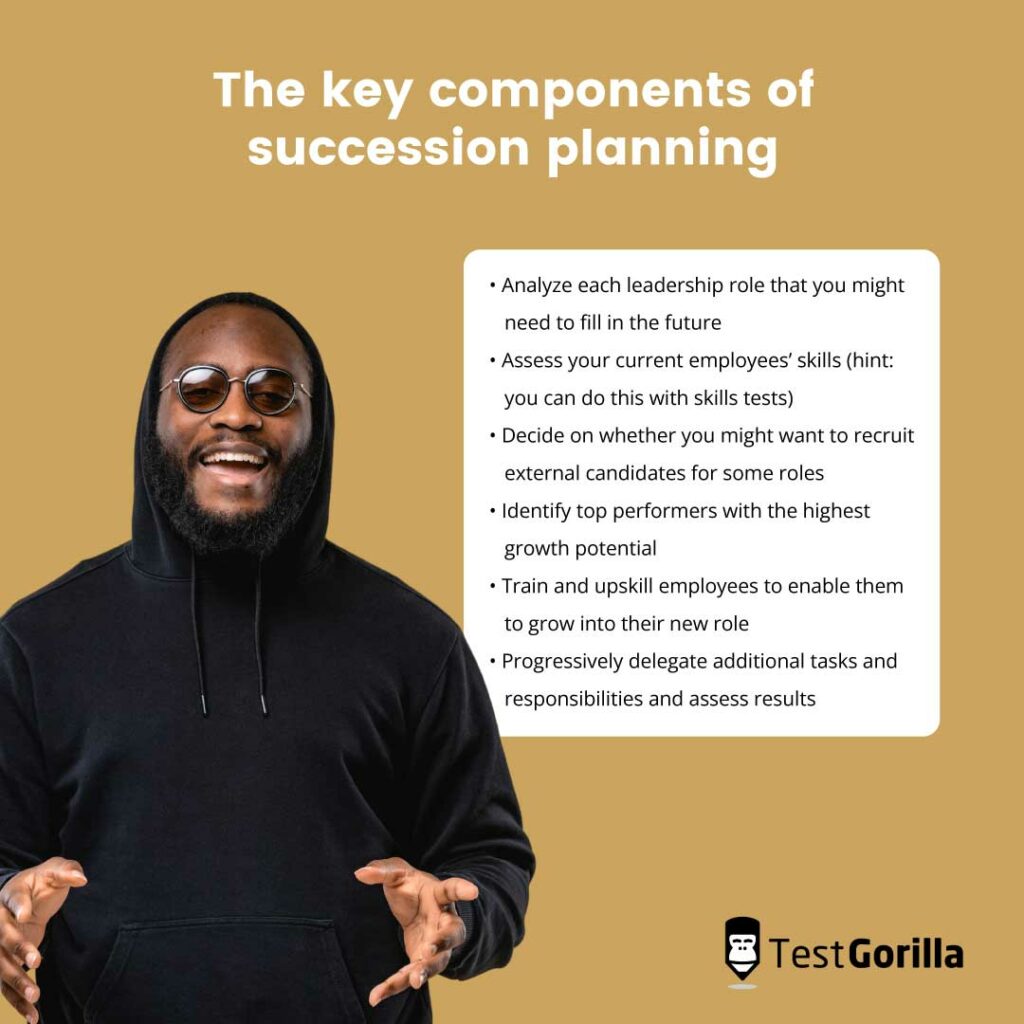No matter how long a senior leader has been at your company, at some point they’ll have to move on. And even if they’ve proven countless times to be loyal to the company, they might leave much sooner than you expect.
For example, they might move to a different city or country for personal reasons, decide to step down as a leader to concentrate on another project, or create their own business.
Regardless of the reasons, you need to be prepared for this eventuality and have a solid succession plan in place – or already know who would replace them.
In this article, we’ll discuss the key components of a successful succession planning strategy and help you get started on developing yours.
To do this, we’ve selected 10 succession planning quotes from experts in the field to inspire you and give you some important context.
Table of contents
The key components of succession planning
Succession planning has certain crucial components. To succeed, you need to:
Analyze each leadership role that you might need to fill in the future
Assess your current employees’ skills (hint: you can do this with skills tests)
Decide on whether you might want to recruit external candidates for some roles
Identify top performers with the highest growth potential
Train and upskill employees to enable them to grow into their new role
Progressively delegate additional tasks and responsibilities and assess results
Succession plans can be:
Long-term, for roles you expect to be vacant in a few years from now.
Or they may be for emergencies, if someone leaves unexpectedly.
Even for emergencies, it’s important to have plans in place before the actual situation arises.
Top 10 inspirational succession planning quotes to help you build a stronger succession plan
Let’s now look at our selection of the top 10 inspirational succession planning quotes. For each quote, we’ll give you the quote first and explain what you can learn from it.
1. On the detrimental effects of a lack of planning
“When an employee leaves, there is a ripple effect. It may be most evident when the key leader leaves, but the hole created when an employee leaves his or her position can be profound, even at lower levels.
Replacing employees can be a difficult task, especially in industries with noted talent shortages and skills gaps. It can be a lengthy process to get a replacement employee to full productivity. A lack of planning can especially sink smaller and family businesses, which don’t have the sheer candidate numbers to choose from.”
Alexander S. Gillis from TechTarget
A lack of succession planning can have a detrimental effect on or even sink your business, especially if you don’t have a large candidate pool. To mitigate this risk, there are two main things you can do, ideally in parallel, to build a succession plan:
Identify your best talent internally (a Leadership and People Management test will help with that)
Expand your talent pool to make it easier to adapt to disruptions
2. On growth and intrinsic motivation
“Intrinsic motivation is the key to growth, but conventional performance management systems destroy that motivation. Almost everyone wants to improve. Traditional apprenticeship models are based on this notion. An inexperienced worker wants to learn, and will learn best when paired with a more expert partner who teaches them.”
From Work Rules by Laszlo Bock, the former senior vice president of people operations at Google.
Bock, in his deep analysis of Google’s culture and hiring practices, points out that nearly everybody is eager to learn and grow, especially when they have adequate support and guidance from more senior colleagues.
To build a strong succession plan, you need to make use of your employees’ natural willingness to grow and take on more responsibilities – and do this before they step into a new role. By showing your best performers you’re willing to invest in and support them in the long run, you’re increasing your chances of retaining them. This will help ensure a smooth transition of knowledge between the different generations of leaders.
3. On helping successors grow
“(…) [Sharing] can occur concurrently between the worker and the potential successor, giving the successor the unique opportunity to gain useful skills and knowledge without a long, on-the-job learning curve.”
From SHRM
To expand on the previous point, it’s best when future leaders can learn directly from your current senior employees. This helps you make sure they can quickly step into their new role, shortening the learning curve and making the transition less stressful for everyone involved.
For this, you can put in place different learning and development initiatives for future successors, such as mentorship and training programs, in which leaders pass on their knowledge and skills.
4. On the importance of direct connections
“Creating direct connections among people across the organization allows them to sidestep cumbersome hierarchical protocols and shorten the time it takes to get things done. It also fosters more direct and instant connections that allow employees to share important information, find answers quickly, and get help and advice from people they trust.”
Boris Ewenstein, Wesley Smith, and Ashvin Sologar for McKinsey & Company
Direct connections are crucial for sharing knowledge and insights in a fluid, non-hierarchical way. Even in the age of remote working, making sure people know each other is key for enabling them to function as a team and to learn from each other.
Direct communication is essential for the success of your change management and succession planning initiatives – and you can still manage all this remotely.
5. On emotional intelligence
“One important development area for any CEO is emotional intelligence, which encompasses flexibility, adaptability, self-control, and relationship management.”
Claudio Fernández-Aráoz, Gregory Nagel, and Carrie Green for Harvard Business Review.
Emotional intelligence is crucial for chief executives and other leadership roles, because it enables greater empathy, adaptability, self-awareness, and flexibility – which, in turn, leads to better relationships, enabling them to set common goals and rally support.
6. On the critical traits that signal potential
“Four critical traits – curiosity, insight, engagement, and determination – signal potential, and with the proper coaching and support, people who demonstrate them can be groomed for high-level positions.”
Claudio Fernández-Aráoz, Gregory Nagel, and Carrie Green for Harvard Business Review
The authors of this article discuss four critical traits that signal strong leadership potential:
Curiosity
Insight
Engagement
Determination
As we all know, growth can be uncomfortable. However, these traits help employees push beyond their own potential resistance and discomfort and set higher standards for themselves and their teams.
7. On training our own successors
“When making a succession plan for your organization, keep in mind that your own role will someday require backfilling. Maybe you’ll decide to take advantage of a new opportunity, or you’ll put in your time and retire from the workforce.
So it’s important to ask yourself, which employee could step into your shoes one day? And what can you do, starting now, to help that person prepare for the transition?”
From Robert Half’s blog.
Having a succession plan for key positions is essential for ensuring the smooth functioning of your business – so have you thought about your own role? HR staff, especially at higher positions, also need to ensure that a smooth transition is possible when they decide to leave.
8. On leveraging technology
“Discussions of rising talents, progression and succession decisions can be done virtually and in shorter sessions (…).
Leveraging digital technology and platforms can build downtime into the process, allowing executives a chance to reflect. But it also permits remote talent assessments, video field reports and video interviews.”
Vibhas Ratanjee for Gallup.
Using the right tech stack can make your succession plan easier to execute.
You can assess talent remotely (skills tests are the best way to do this), use video interviews and asynchronous communication channels, and even measure career growth with different talent-management platforms.
9. On reskilling and upskilling
“We have the tools at our disposal. The bounty of technological innovation which defines our current era can be leveraged to unleash human potential. We have the means to reskill and upskill individuals in unprecedented numbers.”
Professor Klaus Schwab, the World Economic Forum’s Founder and Executive Chairman.
Continuously reskilling and upskilling your workforce enables you not only to meet market challenges and disruptions but also to prepare them for taking on more responsibilities and even stepping into leadership roles – and the technology to do this is already here.
10. On the importance of planning for the future
“To be successful, succession planning teams must identify the core competencies required for a broad range of key positions, including those that may not even exist today.”
Todd Hoffman and Stanley Womack for PwC.
Given how fast the world of work is evolving, you might need to plan for roles that don’t even exist yet. But how can you do this?
The best way to plan for this is to identify those employees with the core competencies to enable them to adapt to a wide range of roles, such as critical thinking, problem solving, cognitive flexibility, creativity, originality, and active learning.
A successful succession plan enables growth and continuity
We hope that these succession planning quotes give you the inspiration you need to start building a succession plan for the most critical roles in your organization.
They cover a wide range of topics, which is necessary: Succession planning is not a simple task and you need to consider many moving parts to ensure the success of your strategy. This includes skills assessments, providing employees with the right conditions to reach their potential, and onboarding them in their new roles.
Also check out our article on the best practices of succession planning to make sure you have all the info you need to get started.
Related posts
Hire the best candidates with TestGorilla
Create pre-employment assessments in minutes to screen candidates, save time, and hire the best talent.
Latest posts
The best advice in pre-employment testing, in your inbox.
No spam. Unsubscribe at any time.

Hire the best. No bias. No stress.
Our screening tests identify the best candidates and make your hiring decisions faster, easier, and bias-free.
Free resources
This checklist covers key features you should look for when choosing a skills testing platform
This resource will help you develop an onboarding checklist for new hires.
How to assess your candidates' attention to detail.
Learn how to get human resources certified through HRCI or SHRM.
Learn how you can improve the level of talent at your company.
Learn how CapitalT reduced hiring bias with online skills assessments.
Learn how to make the resume process more efficient and more effective.
Improve your hiring strategy with these 7 critical recruitment metrics.
Learn how Sukhi decreased time spent reviewing resumes by 83%!
Hire more efficiently with these hacks that 99% of recruiters aren't using.
Make a business case for diversity and inclusion initiatives with this data.




















